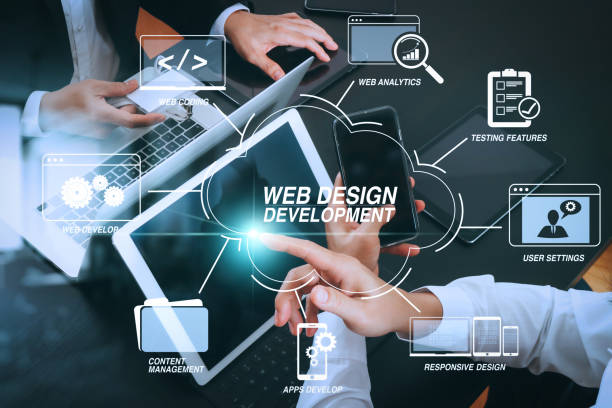The Ideal Kinds Of Website Design to Improve Individual Experience and Interaction
In the ever-evolving landscape of digital interaction, the efficiency of website design considerably affects customer experience and engagement. Different design techniques, such as minimal, responsive, and interactive layouts, each offer distinct benefits that can deal with varied individual requirements. Comprehending which kinds of Web style finest serve these goals can be crucial for services aiming to boost client contentment and retention. The inquiry stays: which layout components really resonate with customers and foster purposeful engagement? The expedition of these principles reveals important insights that might redefine your strategy to website design.
Minimalist Website Design
As digital landscapes end up being increasingly messy, minimal website design has become a powerful approach to enhancing individual experience. This design approach focuses on simpleness, concentrating on vital elements while eliminating unneeded interruptions. By utilizing adequate white space, uncomplicated navigation, and a limited shade palette, minimalist design cultivates clearness and routes user interest to crucial material.
The core principle of minimalist Web layout is to produce a seamless communication for customers. By decreasing cognitive tons, customers can promptly comprehend information without really feeling bewildered. This direct approach not just improves use but additionally urges interaction, as visitors are more probable to check out a site that is simple and aesthetically attractive to navigate.
Additionally, minimal style commonly highlights typography and imagery, making use of these aspects tactically to communicate messages successfully. This focus on important components can enhance brand name identity and develop a memorable user experience. Fundamentally, minimalist Web style is not just a fad; it is a thoughtful approach that identifies the relevance of user-centered style. By removing away extraneous aspects, designers can create an extra appealing, efficient, and satisfying Web experience for all individuals.
Responsive Website Design
In today's diverse electronic environment, receptive Web style has ended up being important for producing a seamless individual experience across a wide variety of devices. As users gain access to sites on smart devices, desktops, laptops, and tablets, the capability of a website to adjust its layout and content to various screen sizes and resolutions is vital.
Receptive website design employs versatile grids, pictures, and CSS media queries to make certain that Web content exists ideally, no matter of the gadget made use of. This strategy not only boosts the aesthetic charm of a website yet likewise substantially improves functionality. Customers are more probable to involve with a site that provides a constant experience, as it removes the disappointment of needing to zoom in or scroll exceedingly.
By adopting responsive layout, companies can boost their exposure and get to a wider audience. In summary, receptive Web design is a fundamental practice that enhances individual experience, interaction, and general complete satisfaction.
Interactive Web Design
Receptive Web layout lays the groundwork for improving individual experience, yet interactive Web layout takes this an action even more by engaging users in an extra dynamic way - Aligned Position Web Design. By including components such as computer animations, clickable prototypes, and real-time comments, interactive Web style astounds users, attracting them into a richer browsing experience
This approach not only promotes engagement however additionally encourages users to explore material proactively instead than passively consuming it. Strategies such as gamification, where customers make rewards for finishing tasks, read here can substantially enhance the time invested in a website and boost overall complete satisfaction. In addition, interactive functions can streamline intricate details, making it extra absorbable and enjoyable.

Incorporating interactive layout elements can also lead to greater conversion prices, as individuals are most likely to involve with a website that actively includes them. Aligned Position Web Design. Eventually, interactive Web design changes customer experiences right into unforgettable trips, making certain that visitors return time and once again
Apartment Design
Defined by its minimalistic strategy, flat style highlights simpleness and performance, removing unneeded components and concentrating on essential features. This style approach focuses on functionality, ensuring that individuals can navigate interfaces effortlessly and performance. By utilizing a tidy aesthetic, flat layout eliminates the mess frequently located in much more luxuriant designs, thus boosting user emphasis on material and functionality.
The hallmark of flat layout lies in its use strong shades, easy typography, and geometric shapes. These elements contribute to an aesthetically attractive user interface that is both approachable and modern. In addition, flat style promotes a sense of clarity, allowing customers to recognize crucial activities and details without interruption.
In addition, flat style is specifically this page effective in receptive Web layout, as its simplicity converts well across various gadgets and display dimensions. The absence of intricate appearances and gradients decreases filling times, which is crucial for keeping individual engagement. As electronic landscapes remain to advance, level design remains an appropriate choice for creating user-friendly internet sites that enhance total experience. By concentrating on essential attributes, level style not only satisfies customer needs however also urges smooth interaction, making it a crucial part of reliable website design methods.
Adaptive Website Design
Adaptive website design customizes the individual experience by developing multiple repaired layouts customized to different display sizes and tools. Unlike responsive style, which fluidly adjusts a solitary design, adaptive design utilizes unique formats for particular breakpoints, making certain optimum presentation on different platforms. This method permits designers to concentrate on the distinct attributes of each device, improving functionality by supplying specifically what customers require based on their context.
Among the key advantages of flexible Web style is its ability to optimize load times and efficiency. By offering tailored material and images that fit the customer's device, internet sites can decrease data usage and boost loading rates. This is particularly beneficial for individuals with slower connections or limited information strategies.

Additionally, flexible layout assists in a more constant and regulated branding experience. Given that developers develop multiple designs, they can make certain that the aesthetic elements line up with the brand name's identification throughout various platforms - Aligned Position Web Design. This leads to a natural customer experience, improving interaction and promoting customer retention
Final Thought
In verdict, the assimilation of minimal, receptive, and interactive Web style concepts substantially boosts individual experience and interaction. Minimal his comment is here style fosters clearness and focus, while responsive design ensures flexibility throughout various tools, promoting access. Interactive design mesmerizes customers via dynamic aspects, encouraging exploration and personalization. Collectively, these layout approaches add to the production of user-friendly atmospheres that not just boost satisfaction however additionally drive greater conversion prices, highlighting their critical importance in modern Web layout methods.

Minimalist design fosters clarity and focus, while responsive design ensures versatility throughout numerous gadgets, promoting availability. Jointly, these layout comes close to contribute to the creation of easy to use settings that not only boost satisfaction however likewise drive greater conversion prices, highlighting their crucial importance in contemporary Web style techniques.